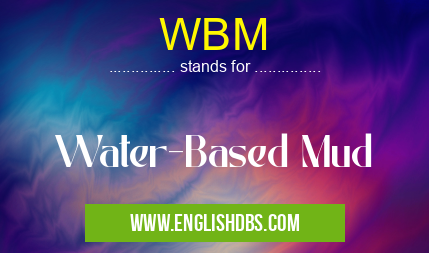What does WBM mean in ENGINEERING
WBM (Water-Based Mud) is a type of drilling fluid used in oil and gas drilling operations. It is a suspension of clay, water, and chemicals that is used to cool and lubricate the drill bit and to carry cuttings out of the hole.

WBM meaning in Engineering in Academic & Science
WBM mostly used in an acronym Engineering in Category Academic & Science that means Water-Based Mud
Shorthand: WBM,
Full Form: Water-Based Mud
For more information of "Water-Based Mud", see the section below.
Components of WBM
- Water: The primary component of WBM is water, which makes up around 80-90% of the total volume.
- Clay: Clay is added to WBM to provide viscosity and to help suspend cuttings. The most common type of clay used is bentonite.
- Chemicals: Various chemicals are added to WBM to improve its performance. These chemicals can include:
- Dispersants: These chemicals help to keep the clay particles dispersed and prevent them from clumping together.
- Thinners: These chemicals help to reduce the viscosity of WBM.
- Weighting agents: These chemicals are added to increase the density of WBM.
- Corrosion inhibitors: These chemicals help to protect the drill pipe and other equipment from corrosion.
Advantages of WBM
- Low cost: WBM is one of the most cost-effective drilling fluids available.
- Environmentally friendly: WBM is biodegradable and does not pose a significant environmental risk.
- Non-toxic: WBM is non-toxic and safe to use in sensitive environments.
- Versatile: WBM can be used in a wide variety of drilling conditions.
Disadvantages of WBM
- High water content: The high water content of WBM can lead to problems with fluid loss and formation damage.
- Low lubricity: WBM has a lower lubricity than oil-based muds, which can lead to increased wear on the drill bit.
- Susceptibility to contamination: WBM is susceptible to contamination by solids and other fluids, which can affect its performance.
Essential Questions and Answers on Water-Based Mud in "SCIENCE»ENGINEERING"
What is Water-Based Mud (WBM)?
Water-based mud (WBM) is a type of drilling fluid composed primarily of water, in contrast to oil-based muds or synthetic-based muds. WBMs are often used in drilling operations where the formation is water-sensitive or where environmental regulations restrict the use of oil-based muds.
What are the advantages of using WBM?
WBMs offer several advantages, including:
- Low cost compared to oil-based muds
- Non-flammable, reducing fire risks
- Lower toxicity, making them more environmentally friendly
- Compatible with water-sensitive formations
What are the disadvantages of using WBM?
WBMs also have some disadvantages, such as:
- Lower lubricity compared to oil-based muds, which can increase torque and drag
- Susceptibility to contamination by salts, which can affect their rheological properties
- Prone to bacterial growth, requiring regular biocide treatment
What are the key components of a WBM?
WBMs typically consist of:
- Water as the base fluid
- Clay particles to provide viscosity and solids control
- Polymers to enhance suspension and cuttings encapsulation
- Defoamers to prevent foam buildup
- Biocides to inhibit bacterial growth
How are WBMs formulated and maintained?
WBM formulation and maintenance involve monitoring and adjusting various parameters, including:
- pH levels to prevent clay hydration and flocculation
- Salinity to control osmotic pressure and clay swelling
- Viscosity to ensure proper hole cleaning and cuttings transport
- Density to maintain wellbore pressure control
When is WBM typically used in drilling operations?
WBMs are commonly used in:
- Drilling through water-sensitive formations, such as shales or claystones
- Drilling in areas with strict environmental regulations
- Drilling shallow to medium-depth wells
- Workover and completion operations
Final Words: WBM is a versatile and cost-effective drilling fluid that is used in a wide variety of drilling operations. It is environmentally friendly and non-toxic, but it has some limitations, such as its high water content and low lubricity.
WBM also stands for: |
|
| All stands for WBM |
